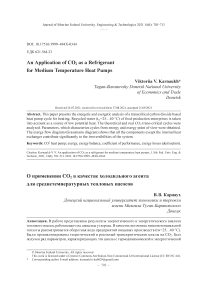An application of CO2 as a refrigerant for medium temperature heat pumps
Автор: Karnaukh Viktoriia V.
Журнал: Журнал Сибирского федерального университета. Серия: Техника и технологии @technologies-sfu
Статья в выпуске: 6 т.14, 2021 года.
Бесплатный доступ
This paper presents the energetic and exergetic analysis of a transcritical carbon dioxide based heat pump cycle for heating. Recycled water (tw=25…40 °C) of food production enterprises is taken into account as a source of low potential heat. The theoretical and real CO2 trans-critical cycles were analysed. Parameters, which characterize cycles from energy and exergy point of view were obtained. The exergy flow diagram (Grassmann diagram) shows that all the components except the internal heat exchanger contribute significantly to the irreversibilities of the system.
Co2 heat pump, exergy, exergy balance, coefficient of performance, exergy losses (destruction)
Короткий адрес: https://sciup.org/146282321
IDR: 146282321 | УДК: 621.564.23 | DOI: 10.17516/1999-494X-0344
Список литературы An application of CO2 as a refrigerant for medium temperature heat pumps
- Klemeš J. J., Varbanov P. S., Lam H. L. Water footprint, water recycling and food-industry supply chains. Handbook of waste management and co-product recovery, 2009, 134-168, 10.1533/9781845697051.2.134. Access: https://www.researchgate.net/publication/288763712_Water_footprint_water_recycling_and_food-industry_supply_chains. DOI: 10.1533/9781845697051.2.134.Access
- Aniko N. Toth. The Geothermal Potential of CO2 Based Heat Pumps Used in an Abandoned Coal Mine. Proceedings, Fourtieth Workshop on Geothermal Reservoir Engineering Stanford University, Stanford, California, January 26-28, 2015. Access: https://www.researchgate.net/publication/272743064.
- Baomin Daia, Pu Zhao, Shengchun Liu, Mingqiang Su, Dan Zhongb, Jiabao Qiana, Xiaowei Hu, Ying Hao. Assessment of heat pump with carbon dioxide/low-global warming potential working fluid mixture for drying process: Energy and emissions saving potential. Int.J. Energy Conversion and Management 222, 2020, 113225, 1-17.
- Sarkar J., Bhattacharyya S., Gopal M. Ram. Transcritical Carbon Dioxide Based Heat Pumps: Process Heat Applications. International Refrigeration and Air Conditioning Conference, 2004. Paper 691. Access: https://docs.lib.purdue.edu/cgi/viewcontent.cgi?article=1690&context=iracc.
- Alptug Yataganbaba, Ali Kilicarslan, I˙ rfan Kurtbas. Exergy analysis of R1234yf and R1234ze as R134a replacements in a two evaporator vapour compression refrigeration system. Int. J. of refrigeration, 2015, 60, 26-37. 10.1016/j.ijrefrig.2015.08.010 Access: https://www.researchgate.net/publication/283835765_ Exergy_analysis_of_R1234yf_and_R1234ze_as_R134a_replacements_in_a_two_evaporator_vapour_compression_refrigeration_system). DOI: 10.1016/j.ijrefrig.2015.08.010Access
- Kashif Nawaz, Bo Shen, Ahmed Elatar, Van Baxter, Omar Abdelaziz, Performance optimization of CO2 heat pump water heater. International Journal of Refrigeration, 2017, 10.1016/j.ijrefrig.2017.09.027. Access: https://www.researchgate.net/publication/320406720_Performance_optimization_of_CO_2_heat_pump_water_heater. DOI: 10.1016/j.ijrefrig.2017.09.027.Access
- Spoelstra M. S., Zondag H. A., Wemmers A. K. An estimation of the European industrial heat pump market potential. Int. J. Renewable and Sustainable Energy Reviews, 2021, 139, Access: https://www.researchgate.net/publication/348684396_An_estimation_of_the_European_industrial_heat_pump_market_potential).
- Shuai Deng, Ruzhu Wang, аnd Yanjun Dai. A comparative analysis on experimental performance of CO2 trans-critical cycle. Int. J. HVAC&R Research, 2014, 20, 1-13. DOI: 10.1080/10789669.2014.913959
- J. Sarkar, Souvik Bhattacharyya, M. Ram Gopal. Transcritical CO2 heat pump systems: exergy analysis including heat transfer and fluid flow effects. Int. J. Energy Conversion and Management, 2005, 46, 2053-2067. 10.1016/j.enconman.2004.10.022 Access: https://www.researchgate.net/publication/223491227_Transcritical_CO2_heat_pump_systems_Exergy_analysis_including_heat_transfer_and_fluid_flow_effects). DOI: 10.1016/j.enconman.2004.10.022Access


